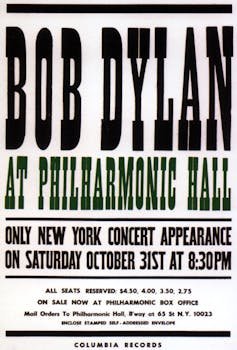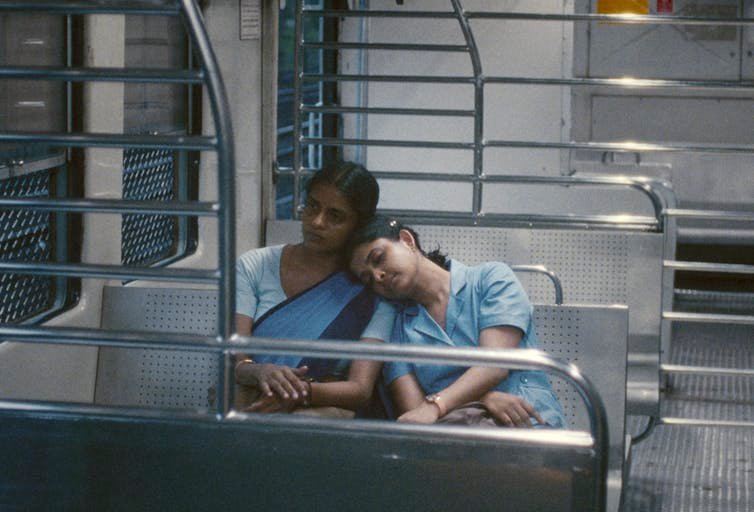In some movies, religion hits viewers over the head – including films that take home the industry’s biggest prizes. No one could miss religion’s importance in “The Exorcist” or “Jesus Christ Superstar,” both nominated for Oscars 50 years ago. Martin Scorsese, whose “Killers of the Flower Moon” is up for 10 at the 2024 Academy Awards, is working on a new project on the life of Jesus.
Anyone can find a religious meaning in “Kundun,” Scorsese’s epic about the Dalai Lama’s youth, or “Fiddler on the Roof,” the story of life in a Russian Jewish shtetl at the turn of the 20th century. Cinematic Christ figures are a dime a dozen.
But for scholars of religion and popular culture like myself, movies that engage religion less directly are often more intriguing.
Free from illusion
Take the hugely influential science fiction franchise “The Matrix.” Depicting characters caught in a diabolical computer simulation, held prisoner to AI, the film feels particularly timely in 2024.
Seeing past illusions to a deeper cosmic reality, as the film’s protagonists must do, is of course a theme of many faiths. “The Matrix” is peppered with many other allusions to religion and mythology. Main character Neo, referred to as “the One,” is killed and resurrected. A hacker even tells him, “You’re my savior, man, my own personal Jesus Christ.” One central character is named Trinity. Another is called Morpheus, after the Greek god of dreams.

Ronald Siemoneit/Sygma/Sygma via Getty Images
More specifically, religion scholars see explicit themes of Gnosticism, a variant of Christianity that flourished during the faith’s first few centuries. A central focus of Gnostic texts is attaining liberation from worldly illusion through direct inner knowledge of truth. Its teachings include stark dualism – light vs. dark, mind vs. body, good vs. evil – and belief in a hidden God operating in a hostile cosmos, both of which have analogues in “The Matrix.”
Buddhist themes are also unmistakable. The film begins with Neo waking up, both literally and figuratively, as he discovers the truth: Machines have trapped humanity in pods to harvest their energy. The world in which humans believe they are living is actually “the matrix,” an illusory world created to distract them.
“Buddha” means “awakened one,” and many viewers have drawn comparisons between Keanu Reeves’ character’s journey and Buddhism. Once awakened to reality, Neo is no longer bound to the illusions of ignorance and desire. Just as importantly, he must help other humans awaken and escape the cycle of suffering.
Spirits on screen
Even apart from specific allusions like these, cinema shares something important with religion.
S. B. Rodriguez-Plate, a religion scholar at Hamilton College, argues that films can function something like religions in the lives of their audiences, “playing God” by creating imaginary worlds – worlds that may make viewers see their real lives in a different light.

Yoshikazu Tsuno/AFP via Getty Images
That power is nowhere more evident than in animated films, which create vivid realms that live action can only dream of. In films like “Spirited Away” and “Howl’s Moving Castle,” legendary anime director Hayao Miyazaki creates his own mythic worlds populated with fanciful “yōkai”: creatures that are inspired by Japanese legends but not quite Shinto or Buddhist.
Many of Miyazaki’s films also include spirits that inhabit inanimate objects, which he associates with Japanese tradition. “In my grandparents’ time … it was believed that spirits (kami) existed everywhere – in trees, rivers, insects, wells, anything,” he once said. “My own religion, if you can call it that, has no practice, no Bible, no saints, only a desire to keep certain places and my own self as pure and holy as possible.”
“Princess Mononoke,” Miyazaki’s 1997 film set in medieval Japan, tells the story of a young prince drawn into an epic struggle between forest gods and humans who exploit natural resources. It’s a challenge religions have often ignored but are increasingly trying to engage: how to live responsibly in the natural world.
While the movie has an environmental message, it avoids oversimplifying the struggle to “good nature” besieged by “bad humans.” San, a human girl who leads an army of wolves, tries to kill the prince, while Iron Town provides support for lepers and outcasts, even as it degrades the environment.
Birth and rebirth – and groundhogs
What about comedy, though? Can a religious film be funny? Could a romantic comedy have religious overtones?
Each February, many Americans celebrate Groundhog Day, waiting to see if the famous Punxsutawney Phil will see his shadow. But for some, Feb. 2 is a day to celebrate “Groundhog Day” – the film about the moral evolution of an arrogant Pittsburgh weatherman sent to report on the groundhog but forced to live the same day over and over again until he gets it right.
Given “Groundhog Day’s” cult-classic status, it evidently speaks to followers of many religions and none. But it’s hard to think of a film that better captures the concept of samsara: the Sanskrit term for the tedious human condition, with its endless cycles of birth and rebirth. Helping people find release from samsara is central to both Hinduism and Buddhism. Phil, the weatherman stuck reliving Feb. 2 over and over, is caught on such a treadmill.

Columbia Pictures/Archive Photos/Moviepix via Getty Images
Only by gradually transforming himself into a more virtuous person – performing acts of merit among the people of Punxsutawney – does he finally escape from the nightmare of recurring Groundhog Days.
Director Harold Ramis was brought up Jewish but became a Buddhist who carried a laminated card, “The 5 Minute Buddhist”: a kind of cheat sheet of core ideas of Buddhism. So it’s not surprising to find them in his movie.
One is “pratītyasamutpāda,” another Sanskrit term: the idea that everything in the cosmos is linked by causal chains. All causes and effects are connected; nothing stands wholly apart on its own. By the end of “Groundhog Day,” the prideful Phil has fully connected with people in the quaint Pennsylvania village – and won his love, Rita – having learned how his own well-being depends on the well-being of everyone around him.
Close to awe
There’s one more way to think about religion in film. Apart from specific spiritual themes, a powerful movie can offer an almost religious experience.
Nathaniel Dorsky, an experimental filmmaker influenced by Buddhism, writes of cinema as a devotional experience. The act of sitting in darkness, watching an illuminated world flicker by, Dorsky says, may be as close to approaching the transcendent as many of us will come – getting a glimpse of something beyond our normal range of experience.
Of course, all these films can be enjoyed fully without reading them on this religious level. Some movie fans would object that these interpretations spoil the fun, and they may have a point. But part of the excitement of studying religion in popular culture is to be aware of its many permutations, hidden in plain view.
This article has been updated to correct the name of religion scholar S. B. Rodriguez-Plate.










